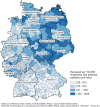Patients potentially in need for palliative care in Germany-A regional small-area estimation based on death registry data
- PMID: 40643778
- PMCID: PMC12254454
- DOI: 10.1007/s43999-025-00070-4
Patients potentially in need for palliative care in Germany-A regional small-area estimation based on death registry data
Erratum in
-
Correction: Patients potentially in need for palliative care in Germany-A regional small-area estimation based on death registry data.Res Health Serv Reg. 2025 Aug 20;4(1):12. doi: 10.1007/s43999-025-00072-2. Res Health Serv Reg. 2025. PMID: 40833561 Free PMC article. No abstract available.
Abstract
Background: Demographic change and the increasing prevalence of chronic illnesses lead to a higher demand for palliative care. Currently, little is known about potential need for palliative care at a small-area level in Germany. However, this is crucial for the planning of services. We aimed to calculate the proportion of the population potentially in need of palliative care on a small-area level and to illustrate the nationwide variations.
Methods: Retrospective cross-sectional study based on causes of death statistics in Germany. Causes of death of all adult deceased in Germany in 2022 were included. The potential need for palliative care was identified based on Murtagh et al. (2014) using ICD-10-codes. Geographic variation was analyzed on district level.
Results: 1,062,452 persons were documented in the causes of death statistics, of which 752,643 died with a potential palliative care need (70.8%). Overall mean age was 79.5 years (SD 12.7), 50.1% were female (n = 532,248). Most deaths were due to neoplasms (23,675; 22.6%) and cardiovascular diseases (230,338, 21.7%). The numbers of deceased with potential need per 100,000 inhabitants varied between districts from 578 to 1,438, with highest values in districts in Saxony, Thuringia, Saxony-Anhalt, and lowest in Bavaria and Baden-Wuerttemberg.
Discussion: Our definition of potential palliative care need included both deaths due to oncological diseases, who commonly receive palliative care, and non-oncological conditions. The findings highlight the regional differences in potential palliative care need on small-area level and the importance of comprehensive healthcare planning adapted to the specific needs of individuals.
Keywords: Death registry data; End-of-life care; Palliative care; Palliative care need; Regional analysis.
© 2025. The Author(s).
Conflict of interest statement
Declarations. The following statements should be included under the heading “Statements and Declarations” for inclusion in the published paper. Please note that submissions that do not include relevant declarations will be returned as incomplete. Ethics approval and consent to participate: The database provided by the Federal Statistical Office does not contain any personal data and is therefore open to the public. Although ethical approval is not required, the study was reviewed by the Local Research Ethics Committee of Ludwig-Maximilians-University Munich and a waiver has been granted (reference number 24–0533 KB). The database does not contain any personal data and therefore no consent to participate was required. Consent for publication: The database does not contain any personal data and therefore no consent to publish was required. Competing interests: All authors certify that they have no affiliations with or involvement in any organization or entity with any financial interest or non-financial interest in the subject matter or materials discussed in this manuscript.
Figures
References
-
- World Health Organization (2025) Palliative care. https://www.who.int/health-topics/palliative-care Accessed 2025
-
- Radbruch L, Payne S (2009) White paper on standards and norms for hospice and palliative care in europe: part 1. Eur J Palliat Care 16(6):278–289
-
- Leitlinienprogramm O (2020) Erweiterte S3-Leitlinie palliativmedizin für patienten Mit einer nicht-heilbaren krebserkrankung. Langversion 2.2. https://www.dgpalliativmedizin.de/images/stories/pdf/LL_Palliativmedizin... Accessed 2024.
-
- Murtagh FE, Bausewein C, Verne J, Groeneveld EI, Kaloki YE, Higginson IJ (2014) How many people need palliative care? A study developing and comparing methods for population-based estimates. Palliat Med 28(1):49–58. 10.1177/0269216313489367 - PubMed
-
- Morin L, Aubry R, Frova L, MacLeod R, Wilson DM, Loucka M et al (2017) Estimating the need for palliative care at the population level: A cross-national study in 12 countries. Palliat Med 31(6):526–536. 10.1177/0269216316671280 - PubMed
LinkOut - more resources
Full Text Sources



